Weekly recap
Markets responded positively to several developments last week, including the de-escalation of tensions in the Middle East, dovish comments from several Federal Reserve officials, reports that the US and China had signed a new trade deal, and statements from several U.S. officials indicating that additional trade deals were nearing completion.
On the data front, inflation ticks slightly higher in May, according to the core PCE, the Fed’s preferred measure for inflation. Call PCE rose 0.2% MoM and 2.7% YoY, up from 0.1% and 2.6% in May. Meanwhile, personal spending unexpectedly fell 0.1%. Separately, consumer expectations for inflation in the year ahead dropped from 6.6% in May to 5% in June, suggesting that fears about the potential impact of tariffs on future inflation have eased considerably.
The S&P 500 and the NASDAQ closed the week 3.4% and 4.2% higher, respectively, both at record levels. Meanwhile, the Dow Jones rose over 2.5%, and the US dollar dropped to multi-year lows.
Meanwhile, oil prices plunged 12% as the ceasefire between Israel and Iran stabilised the situation in the Middle East.
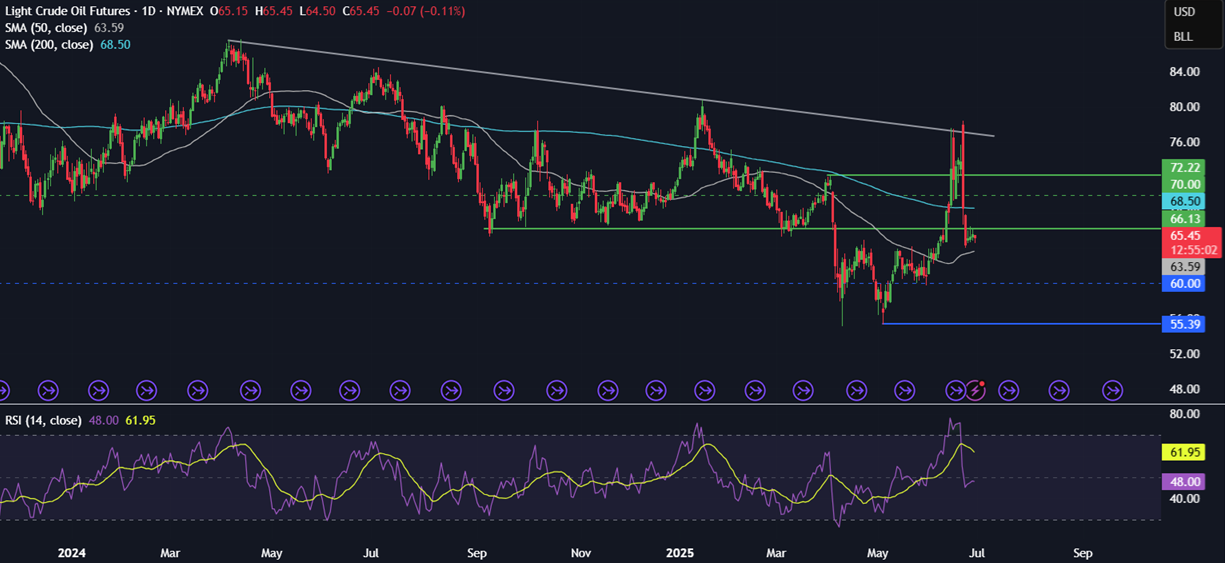
UK GDP (Monday)
UK Q1 GDP data is expected to confirm the preliminary growth rates of 0.7% and 1.3% on a quarterly and annual basis, respectively. The final revision is considered stale now that we’re almost the end of Q2. The strong Q1 growth is viewed as a one-off, as much of it was deemed to have been pulled forward ahead of Trump’s trade tariffs and is unlikely to be repeated throughout the year. The Bank of England expects growth to slow over the rest of the year, with cracks already appearing in the labour market. Industry data last week showed that wage growth slowed below inflation in the private sector, and job vacancies have continued to decline. A downward revision to Q1 GDP data could weigh on the GBP/USD, which is currently trading at a 3.5-year high.
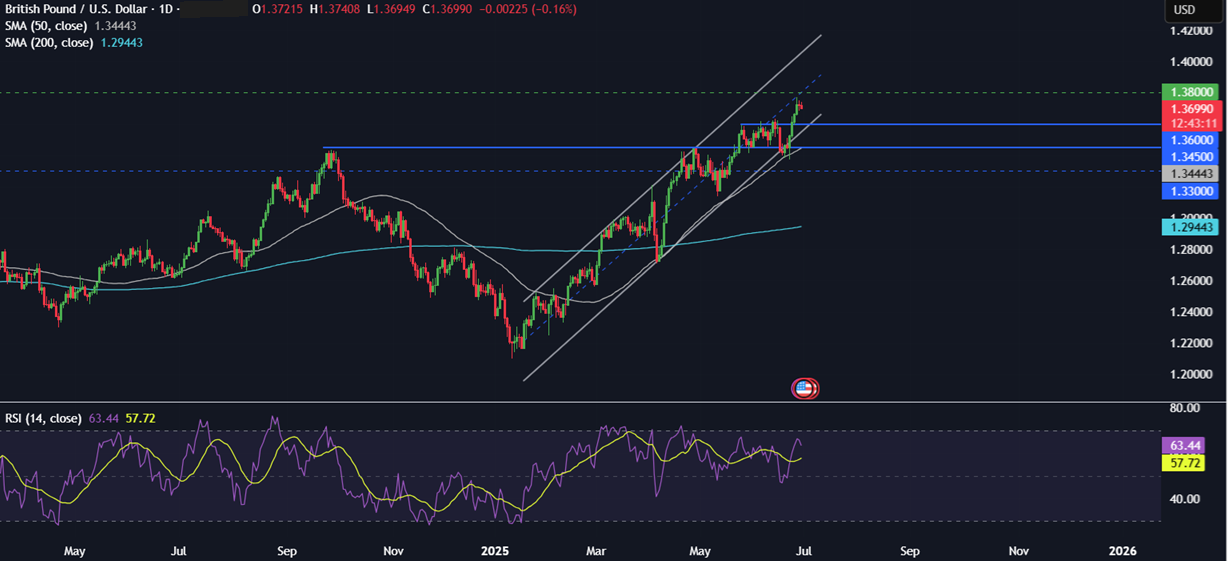
Eurozone CPI (Tuesday)
Eurozone CPI is expected to remain unchanged at 1.9% YoY in June after falling below the ECB’s 2% target level in May for the first time in seven months, down from 2.2% in April. Service sector inflation declined notably in May to 3.7% from 4%. Price pressures could continue to ease further over the coming months owing to falling food prices and the stronger euro, which trades around a four-year high versus the US dollar. The ECB cut interest rates for an eighth straight meeting in June, taking the deposit rate to 2% in a bid to bolster stagnant growth. The ECB appears increasingly more divided over what to do next, with Lagarde hinting at a pause in the July meeting to seek more clarity over Trump’s trade tariffs. However, cooler-than-expected inflation may raise expectations of another rate cut by the central bank, pulling EUR/USD lower. ECB President Lagarde is due to speak on Wednesday.
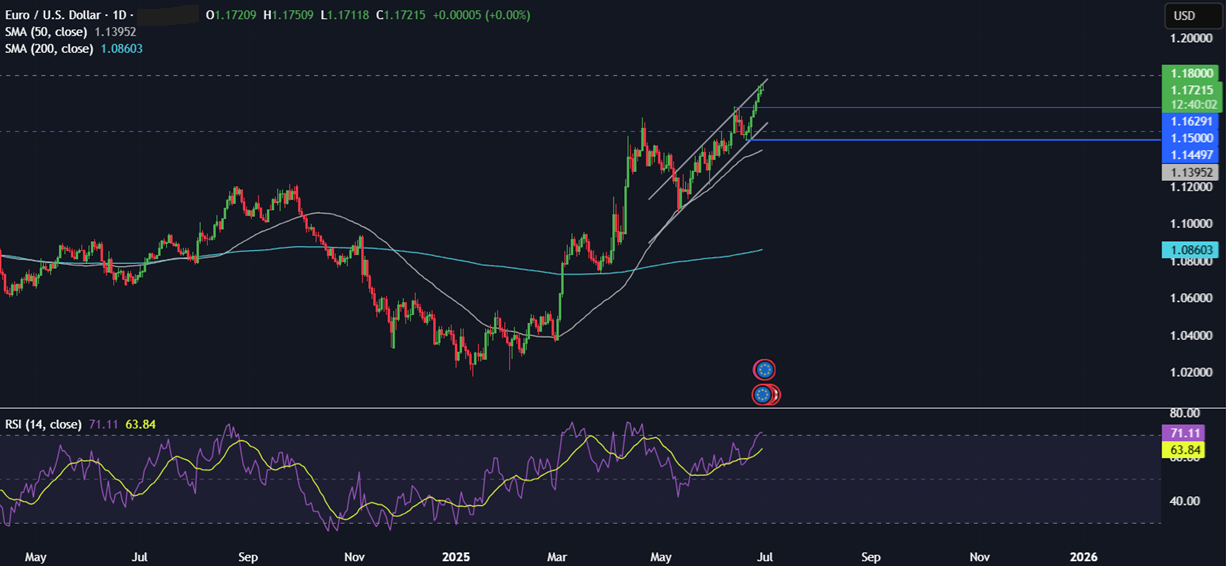
Sinatra ECB Forum Fed Chair Powell (Tuesday)
Sinatra in Portugal hosts the annual ECB forum, where European Central Bankers are joined by their international counterparts to exchange views on current policy issues. Federal Reserve Chair Jerome Powell’s comments will be closely watched following his testimony before Congress last week and amid increased criticism from President Trump. Fed Chair Powell has adopted a cautious approach to cutting interest rates further this year, amid expectations that inflation will creep higher due to Trump’s trade tariffs. However, the data so far has not shown any meaningful uptick in inflation. Powell acknowledged this last week, saying that if there wasn’t an uptick in inflation, the Fed could continue to cut rates. If Powell reiterates this point, market rate cut expectations could rise, which could pull USD lower and lift stock indices such as the S&P 500.
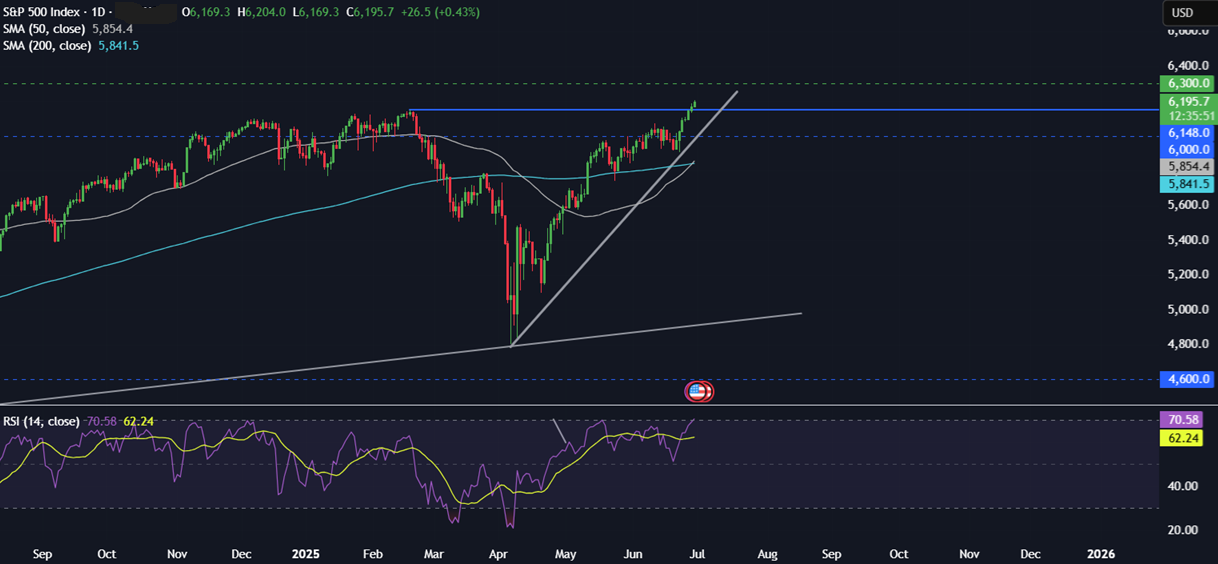
Tankan Survey (Tuesday)
The Bank of Japan tankan survey is the first major confidence gauge since the implementation of new US auto tariffs. It is forecast to show a slight deterioration in business sentiment among both large manufacturers and small manufacturers. The data is expected to show export headwinds growing due to global trade tensions, which are weighing on the outlook. The external demand picture remains clouded for the auto and auto-related sectors, which are the most vulnerable. In the service sector, sentiment is forecast to remain resilient, underpinned by solid domestic demand amid a stable labour market. Weaker-than-forecast data could pull the yen lower, boosting USD/JPY.
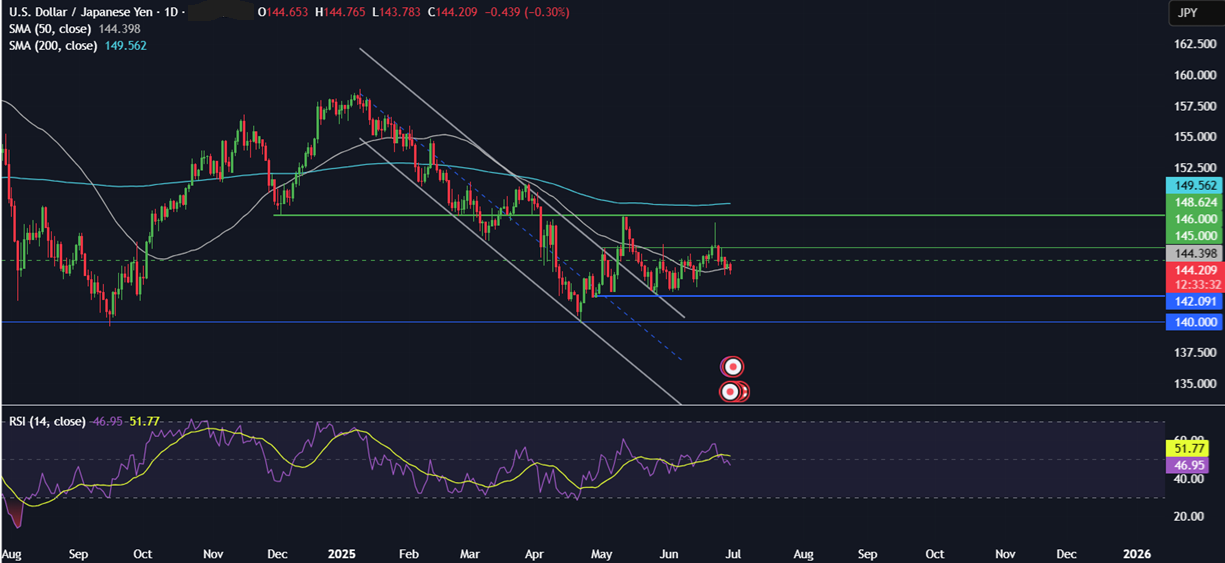
ISM Manufacturing PMI (Tuesday)
Expectations are for ISM manufacturing to contract at a slower pace in June, rising to 48.8, up from 48.5. The level 50 separates expansion from contraction. By comparison, the S&P Global Manufacturing PMI remained at 52 in June, matching May’s 15-month high. The data also showed that price pressures intensified sharply, with input and output prices picking up at the fastest pace since July 2022, with most firms citing tariffs. Manufacturers passed these costs to customers, ramping up inflation concerns. While domestic demand rose, export orders slipped. Investors will be watching to see whether the ISM data signals a similar pattern, which could support a more cautious approach from the Fed in cutting rates and may pull stock indices, such as the Dow Jones, lower.
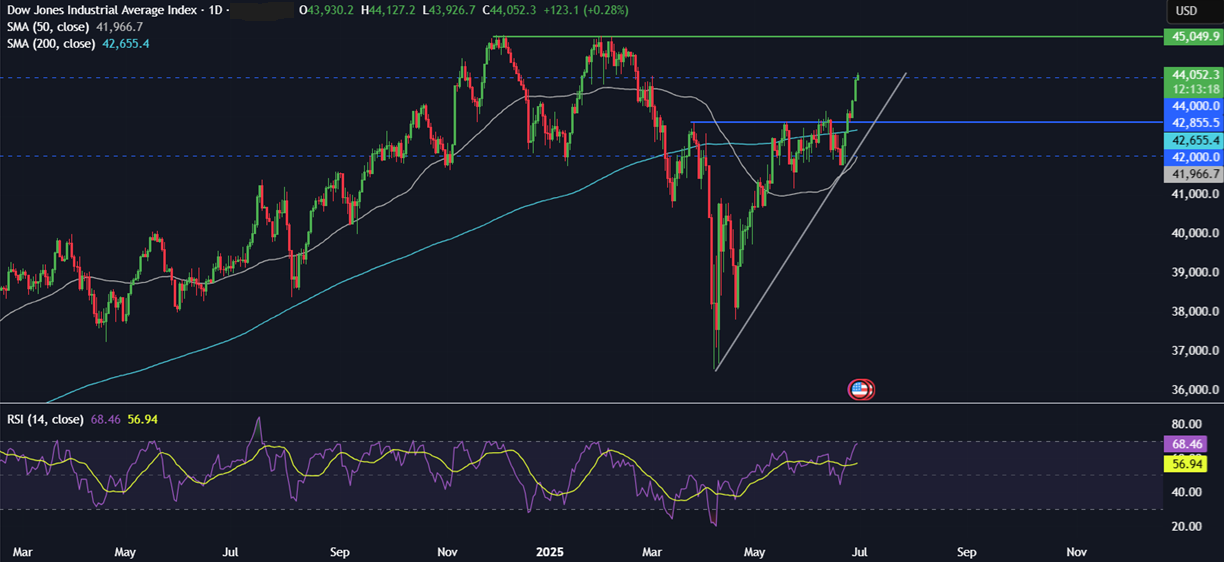
China Caixin PMI (Tuesday & Thursday)
The official PMI data was released today, showing that China’s manufacturing activity contracted for a third consecutive month, reinforcing expectations of further stimulus to support the economy. The official PMI rose to 49.7 in June, up from 49.5 in May. The slower pace of contraction could suggest that the recent reduction in tariffs and a stabilisation globally have started to filter through into economic activity.
The Caixin manufacturing PMI is scheduled for release on Tuesday, followed by the services PMI on Thursday. In both reports, a new export orders sub-index will be closely monitored for any recovery following recent tariff reductions.
Expectations are for the data to show that the Chinese economy remains near a standstill in June. Weaker data could pull the Hang Seng lower.

Non-farm payroll (Thursday)
The non-farm payroll report is scheduled to be released on Thursday, rather than Friday, due to the Independence Day holiday. The US economy is expected to have added 129k jobs in June, down from 139k in May and below a 3-month average of 135k, in a sign of a cooling labour market. Unemployment is expected to remain at 4.2%, as the Fed anticipates it will rise to 4.5% by year-end. Average hourly earnings are expected to cool to 0.3% MoM, down from 0.4% in May.
The data comes as recent jobless claims have been showing more signs of weakness in the labour market, and investors will be watching closely to see whether this is also reflected in the nonfarm payroll report. However, Fed Chair Powell said that the OB market remains solid and only shows very slow continued cooling, which he doesn’t consider troubling. Still, the market could react to weaker-than-expected data, which would likely pull the US dollar lower, while lifting stocks as the market prices in more Federal Reserve rate cuts.
A weaker-than-forecast NFP report could fuel rate cut hopes and lift the Nasdaq 100 to fresh record highs.

Trading involves risk.
The content provided here is for informational purposes only. It is not intended as personal investment advice and does not constitute a solicitation or invitation to engage in any financial transactions, investments, or related activities. Past performance is not a reliable indicator of future results.
The financial products offered by the Company are complex and come with a high risk of losing money rapidly due to leverage. These products may not be suitable for all investors. Before engaging, you should consider whether you understand how these leveraged products work and whether you can afford the high risk of losing your money.
The Company does not accept clients from the Restricted Jurisdictions as indicated in our website/ T&C. Some services or products may not be available in your jurisdiction.
The applicable legal entity and its respective products and services depend on the client’s country of residence and the entity with which the client has established a contractual relationship during registration.




